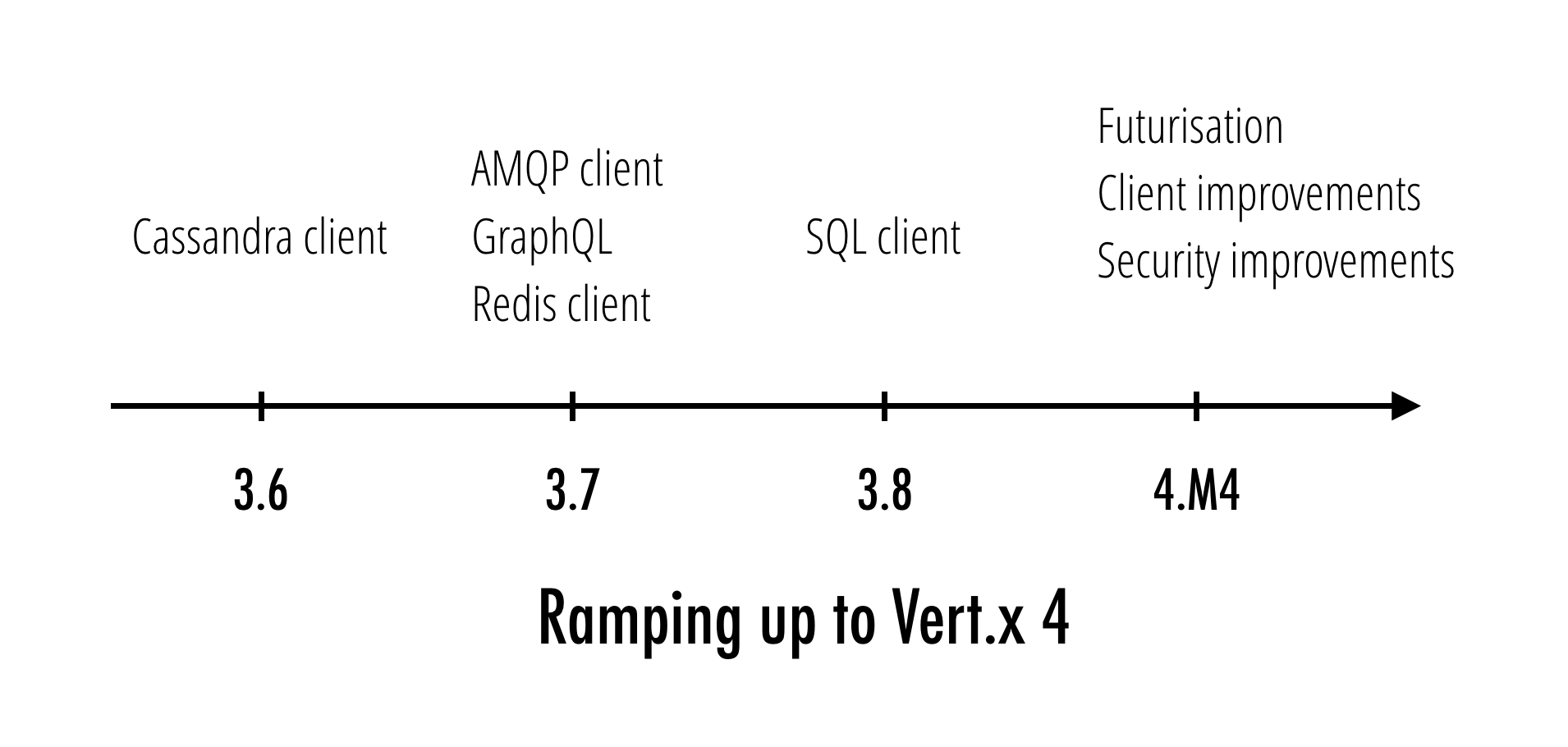Eclipse Vert.x 4 milestone 5 released!
We are extremely pleased to announce the fifth 4.0 milestone release of Eclipse Vert.x.
Vert.x 4 is the evolution of the Vert.x 3.x series that will bring key features to Vert.x.
This release aims to provide a reliable distribution of the current development of Vert.x 4 for people that want to try it and provide feedback.
New kids on the block: Json Schema, Web Validation and Web OpenAPI
we decide to take HTTP request validation in vertx-web and Contract Driven development using OpenAPI
to a next level in Vert.x 4, allow us to introduce:
- Vert.x Json Schema: Extensible sync/async json-schema validator designed for Vert.x JSON types, supporting Json Schema Draft-7 and OpenAPI dialect.
- Vert.x Web Validation: Extensible sync/async HTTP request validator, providing a DSL to describe expected HTTP requests.
- Vert.x Web OpenAPI: New support for Contract Driven development based on OpenAPI
Vert.x Json Schema is a powerful Json Schema validator which includes:
- Async
$refresolution - Custom keywords/Custom dialects support
- A DSL to build schemas
Combining Vert.x Json Schema and Vert.x Web Validation you can easily validate HTTP requests:
ValidationHandler handler = ValidationHandler
.builder(schemaParser)
.pathParameter(Parameters.param("myPathParam", stringSchema()))
.queryParameter(Parameters.optionalParam("myQueryParam", intSchema()))
.body(Bodies.json(Schemas.ref(JsonPointer.fromURI(URI.create(
"some_schema.json"
)))))
.build();
router.post("/{myPathParam}").handler(handler);
Check out the Web validation examples and provide feedback on the APIs!
Vert.x Web Validation allows you to use Vert.x Web API Service without Vert.x Web API Contract: Vert.x Web API Service example
You can achieve Contract Driven development, with Vert.x Web OpenAPI:
RouterFactory.create(vertx, "src/main/resources/petstore.yaml",
routerFactoryAsyncResult -> {
if (routerFactoryAsyncResult.succeeded()) {
// Spec loaded with success, retrieve the router
RouterFactory routerFactory = routerFactoryAsyncResult.result();
// You can enable or disable different features of router factory using RouterFactoryOptions
RouterFactoryOptions options = new RouterFactoryOptions();
// Set the options
routerFactory.setOptions(options);
// Add an handler to operation listPets
routerFactory.operation("listPets").handler(routingContext -> {
// Handle listPets operation
routingContext.response().setStatusMessage("Called listPets").end();
}).failureHandler(routingContext -> { // Add a failure handler to the same operation
// This is the failure handler
Throwable failure = routingContext.failure();
if (failure instanceof BadRequestException)
// Handle Validation Exception
routingContext
.response()
.setStatusCode(400)
.putHeader("content-type", "application/json")
.end(((BadRequestException)failure).toJson().toBuffer());
});
// Add a security handler
// Handle security here
routerFactory.securityHandler(
"api_key",
JWTAuthHandler.create(jwtAuth)
);
// Now you have to generate the router
Router router = routerFactory.createRouter();
} else {
// Something went wrong during router factory initialization
}
});
Vert.x Web OpenAPI is the new way to do Vert.x Web API Contract, however Vert.x Web API Contract remains supported for the whole lifetime of Vert.x 4 to provide a migration path: we will provide soon a migration guide for Vert.x Web API Contract.
Check out the Web OpenAPI examples
SQL Client templates
SQL Client Templates is a small library designed to facilitate the execution of SQL queries.
Simply put you execute prepared SQL queries with a map instead of a tuple:
Map<String, Object> parameters = Collections.singletonMap("id", 1);
SqlTemplate
.forQuery(client, "SELECT * FROM users WHERE id=#{id}")
.execute(parameters)
.onSuccess(users -> {
users.forEach(row -> {
System.out.println(row.getString("first_name") + " " + row.getString("last_name"));
});
});
A template can perform tuple to object mapping for parameters and rows.
Here is row mapping using Jackson Databind.
SqlTemplate
.forQuery(client, "SELECT * FROM users WHERE id=#{id}")
.mapTo(User.class)
.execute(Collections.singletonMap("id", 1))
.onSuccess(users -> {
users.forEach(user -> {
System.out.println(user.firstName + " " + user.lastName);
});
});
You can also uses Vert.x data objects to generate mappers instead: when a data object is annotate with @RowMapped a row mapper
function will be generated
@DataObject
@RowMapped
class User {
...
}
// Generated by SQL template code generator
class UserRowMapper implements java.util.function.Function<io.vertx.sqlclient.Row, User> {
...
}
You can then use this mapper instead of User.class
SqlTemplate
.forQuery(client, "SELECT * FROM users WHERE id=#{id}")
.mapTo(UserRowMapper.INSTANCE)
.execute(Collections.singletonMap("id", 1))
.onSuccess(users -> {
users.forEach(user -> {
System.out.println(user.firstName + " " + user.lastName);
});
});
A new clustering SPI
This milestone introduces the clustering SPI redesign that allows to:
- simplify both Vert.x core and cluster manager implementations
- leverage capabilities of some cluster managers (e.g. data loss protection)
Read the RFC document if you would like to know more.
As a developer, you should not see much difference, the EventBus and Shared data API remain unchanged.
However, if you operate a cluster in production, you cannot mix Vert.x 3 and Vert.x 4 nodes.
The following cluster managers implementations have been updated: vertx-hazelcast, vertx-infinispan and vertx-iginite (thanks Lukas Prettenthaler for your help).
The vertx-zookeeper update will be available in the next release.
Upgrade to Infinispan 10 and Ignite 2.8.0
Following-up on the clustering SPI update :
- the Infinispan cluster manager now depends on Infinispan 10
- the Apache Ignite cluster manager on 2.8.0
Complete refactoring on vertx-auth authn/authz split
Authentication has been decoupled from authorization, all modules now implement at least one of the two interfaces:
AuthenticationProviderAuthorizationProvider
This improvement provides more flexiblity such as user authentication using a property file and authorization against a database.
This milestone also includes a few new implementations:
vertx-auth-ldapsupersedesshirovertx-authpropertiessupersedesshirovertx-auth-sqlto usesql-clients as source of user datavertx-auth-webauthnprovidesFIDO2webauthnauthentication
Many bug fixes have been done and missing features such as JWK rotation support for OAuth2/OIDC/JWT is now implemented.
Vertx-web updates
Vert.x-Web also got some updates.
The session handler code now allows other storages:
cookie-session-store- stores all session data in a cookieredis-session-store- store all session data in a redis key store database
Sessions follows the latest OWASP recommendations and allows to now use cookieless sessions, where the session key is passed in the URL.
Routers are now proxy aware: when enabled, routers can parse the Forward headers and rebind the internal values
for protocol, host and port for user convinience. This is quite useful when applications are deployed behind
a caching server, which can modify the original request.
JUnit 5 support updates
The vertx-junit5 module has had the following updates since the last milestone.
- The internals have been refactored to split the implementation and extensions around a service-provider interface.
While this is largely transparent in terms of API, you need to be aware that:
- the Vertx parameter should be placed before any parameter that requires it for creation, such as when injecting a WebClient,
- the vertx-junit5 module now only offers APIs for the Vert.x core module (vertx-core),
- the reactiverse-junit5-extensions module now hosts extensions that offer extra parameter types like WebClient,
- the RxJava 1 and 2 bindings are now offered as vertx-junit5-rx-java and vertx-junit5-rx-java2 modules in the vertx-junit5-extensions repository.
- The
succeeding()andfailing()methods inVertxTestContexthave been deprecated to improve ergonomics, you should instead usesucceedingThenComplete()andfailingThenComplete().
Ramping up to Vert.x 4
Instead of developing all new features exclusively in Vert.x 4, we introduce some of these features in the 3.x branch so the community can benefit from them. The Vert.x 4 development focus on more fundamental changes that cannot be done in the 3.x series.

This is the fifth milestone of Vert.x 4, you can of course expect more milestones to outline the progress of the effort.
You can also read the previous milestone announces:
- https://vertx.io/blog/eclipse-vert-x-4-milestone-4-released
- https://vertx.io/blog/eclipse-vert-x-4-milestone-3-released
- https://vertx.io/blog/eclipse-vert-x-4-milestone-2-released
- https://vertx.io/blog/eclipse-vert-x-4-milestone-1-released
Finally
The deprecations and breaking changes can be found on the wiki.
The release artifacts have been deployed to Maven Central and you can get the distribution on Maven Central.
You can bootstrap a Vert.x 4.0.0-milestone5 project using https://start.vertx.io.
The documentation has been deployed on this preview web-site https://vertx-ci.github.io/vertx-4-preview/docs/
That’s it! Happy coding and see you soon on our user or dev channels.



